Ontario and British Columbia Forest Policies: A Comprehensive Study
VerifiedAdded on 2023/06/15
|13
|4290
|461
Essay
AI Summary
This essay provides a comparative analysis of forest policies in Ontario and British Columbia, Canada, focusing on the sustainable management and use of Crown forests. It examines the complexities of forest laws, highlighting the evolution of policies since 1867 and their impact on maintaining healthy forests for current and future generations. The essay details the major differences between the two provinces, including regulations on harvest levels, reforestation processes, clear-cutting practices, land conversion policies, plantation forestry, forest health and productivity management, and measures to prevent illegal logging. It further discusses the approaches to endangered species management and water quality management, emphasizing the importance of these policies in ensuring the long-term sustainability and environmental integrity of forests in both Ontario and British Columbia. Desklib offers a wide range of study tools and resources for students.

Running head: FOREST POLICIES
Forest Polices
Name of the Student
Name of the University
Author note
Forest Polices
Name of the Student
Name of the University
Author note
Paraphrase This Document
Need a fresh take? Get an instant paraphrase of this document with our AI Paraphraser
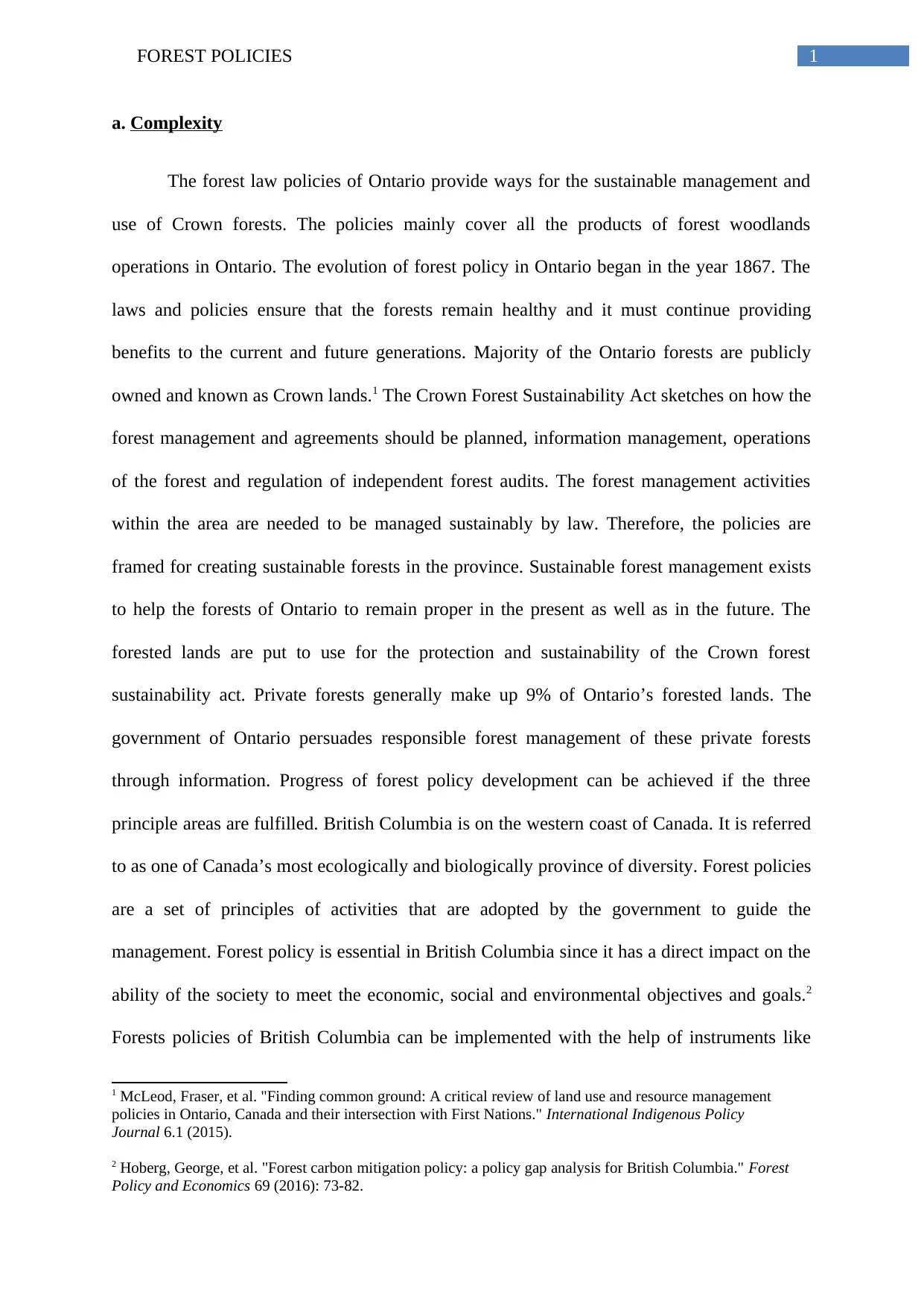
1FOREST POLICIES
a. Complexity
The forest law policies of Ontario provide ways for the sustainable management and
use of Crown forests. The policies mainly cover all the products of forest woodlands
operations in Ontario. The evolution of forest policy in Ontario began in the year 1867. The
laws and policies ensure that the forests remain healthy and it must continue providing
benefits to the current and future generations. Majority of the Ontario forests are publicly
owned and known as Crown lands.1 The Crown Forest Sustainability Act sketches on how the
forest management and agreements should be planned, information management, operations
of the forest and regulation of independent forest audits. The forest management activities
within the area are needed to be managed sustainably by law. Therefore, the policies are
framed for creating sustainable forests in the province. Sustainable forest management exists
to help the forests of Ontario to remain proper in the present as well as in the future. The
forested lands are put to use for the protection and sustainability of the Crown forest
sustainability act. Private forests generally make up 9% of Ontario’s forested lands. The
government of Ontario persuades responsible forest management of these private forests
through information. Progress of forest policy development can be achieved if the three
principle areas are fulfilled. British Columbia is on the western coast of Canada. It is referred
to as one of Canada’s most ecologically and biologically province of diversity. Forest policies
are a set of principles of activities that are adopted by the government to guide the
management. Forest policy is essential in British Columbia since it has a direct impact on the
ability of the society to meet the economic, social and environmental objectives and goals.2
Forests policies of British Columbia can be implemented with the help of instruments like
1 McLeod, Fraser, et al. "Finding common ground: A critical review of land use and resource management
policies in Ontario, Canada and their intersection with First Nations." International Indigenous Policy
Journal 6.1 (2015).
2 Hoberg, George, et al. "Forest carbon mitigation policy: a policy gap analysis for British Columbia." Forest
Policy and Economics 69 (2016): 73-82.
a. Complexity
The forest law policies of Ontario provide ways for the sustainable management and
use of Crown forests. The policies mainly cover all the products of forest woodlands
operations in Ontario. The evolution of forest policy in Ontario began in the year 1867. The
laws and policies ensure that the forests remain healthy and it must continue providing
benefits to the current and future generations. Majority of the Ontario forests are publicly
owned and known as Crown lands.1 The Crown Forest Sustainability Act sketches on how the
forest management and agreements should be planned, information management, operations
of the forest and regulation of independent forest audits. The forest management activities
within the area are needed to be managed sustainably by law. Therefore, the policies are
framed for creating sustainable forests in the province. Sustainable forest management exists
to help the forests of Ontario to remain proper in the present as well as in the future. The
forested lands are put to use for the protection and sustainability of the Crown forest
sustainability act. Private forests generally make up 9% of Ontario’s forested lands. The
government of Ontario persuades responsible forest management of these private forests
through information. Progress of forest policy development can be achieved if the three
principle areas are fulfilled. British Columbia is on the western coast of Canada. It is referred
to as one of Canada’s most ecologically and biologically province of diversity. Forest policies
are a set of principles of activities that are adopted by the government to guide the
management. Forest policy is essential in British Columbia since it has a direct impact on the
ability of the society to meet the economic, social and environmental objectives and goals.2
Forests policies of British Columbia can be implemented with the help of instruments like
1 McLeod, Fraser, et al. "Finding common ground: A critical review of land use and resource management
policies in Ontario, Canada and their intersection with First Nations." International Indigenous Policy
Journal 6.1 (2015).
2 Hoberg, George, et al. "Forest carbon mitigation policy: a policy gap analysis for British Columbia." Forest
Policy and Economics 69 (2016): 73-82.
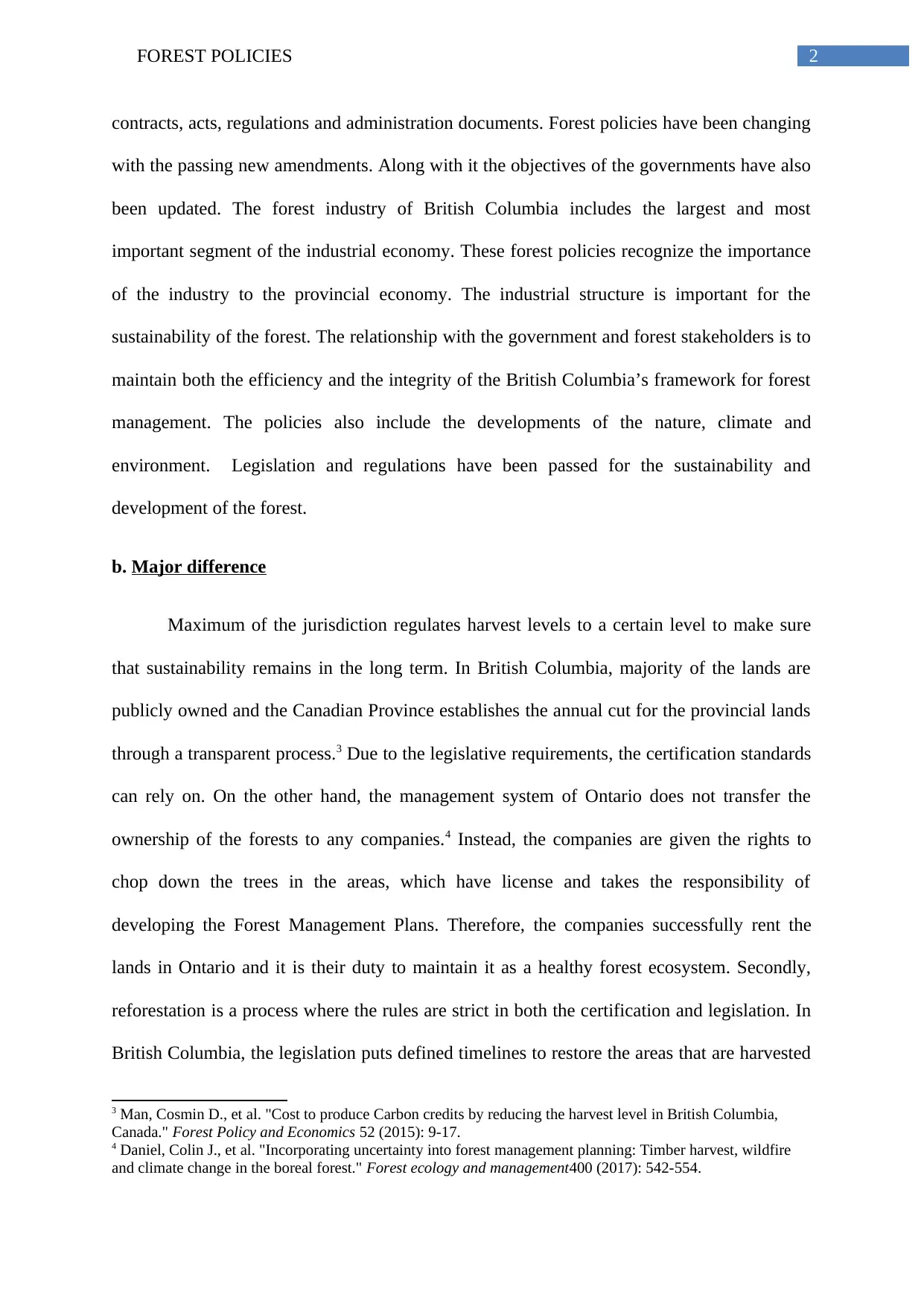
2FOREST POLICIES
contracts, acts, regulations and administration documents. Forest policies have been changing
with the passing new amendments. Along with it the objectives of the governments have also
been updated. The forest industry of British Columbia includes the largest and most
important segment of the industrial economy. These forest policies recognize the importance
of the industry to the provincial economy. The industrial structure is important for the
sustainability of the forest. The relationship with the government and forest stakeholders is to
maintain both the efficiency and the integrity of the British Columbia’s framework for forest
management. The policies also include the developments of the nature, climate and
environment. Legislation and regulations have been passed for the sustainability and
development of the forest.
b. Major difference
Maximum of the jurisdiction regulates harvest levels to a certain level to make sure
that sustainability remains in the long term. In British Columbia, majority of the lands are
publicly owned and the Canadian Province establishes the annual cut for the provincial lands
through a transparent process.3 Due to the legislative requirements, the certification standards
can rely on. On the other hand, the management system of Ontario does not transfer the
ownership of the forests to any companies.4 Instead, the companies are given the rights to
chop down the trees in the areas, which have license and takes the responsibility of
developing the Forest Management Plans. Therefore, the companies successfully rent the
lands in Ontario and it is their duty to maintain it as a healthy forest ecosystem. Secondly,
reforestation is a process where the rules are strict in both the certification and legislation. In
British Columbia, the legislation puts defined timelines to restore the areas that are harvested
3 Man, Cosmin D., et al. "Cost to produce Carbon credits by reducing the harvest level in British Columbia,
Canada." Forest Policy and Economics 52 (2015): 9-17.
4 Daniel, Colin J., et al. "Incorporating uncertainty into forest management planning: Timber harvest, wildfire
and climate change in the boreal forest." Forest ecology and management400 (2017): 542-554.
contracts, acts, regulations and administration documents. Forest policies have been changing
with the passing new amendments. Along with it the objectives of the governments have also
been updated. The forest industry of British Columbia includes the largest and most
important segment of the industrial economy. These forest policies recognize the importance
of the industry to the provincial economy. The industrial structure is important for the
sustainability of the forest. The relationship with the government and forest stakeholders is to
maintain both the efficiency and the integrity of the British Columbia’s framework for forest
management. The policies also include the developments of the nature, climate and
environment. Legislation and regulations have been passed for the sustainability and
development of the forest.
b. Major difference
Maximum of the jurisdiction regulates harvest levels to a certain level to make sure
that sustainability remains in the long term. In British Columbia, majority of the lands are
publicly owned and the Canadian Province establishes the annual cut for the provincial lands
through a transparent process.3 Due to the legislative requirements, the certification standards
can rely on. On the other hand, the management system of Ontario does not transfer the
ownership of the forests to any companies.4 Instead, the companies are given the rights to
chop down the trees in the areas, which have license and takes the responsibility of
developing the Forest Management Plans. Therefore, the companies successfully rent the
lands in Ontario and it is their duty to maintain it as a healthy forest ecosystem. Secondly,
reforestation is a process where the rules are strict in both the certification and legislation. In
British Columbia, the legislation puts defined timelines to restore the areas that are harvested
3 Man, Cosmin D., et al. "Cost to produce Carbon credits by reducing the harvest level in British Columbia,
Canada." Forest Policy and Economics 52 (2015): 9-17.
4 Daniel, Colin J., et al. "Incorporating uncertainty into forest management planning: Timber harvest, wildfire
and climate change in the boreal forest." Forest ecology and management400 (2017): 542-554.
⊘ This is a preview!⊘
Do you want full access?
Subscribe today to unlock all pages.

Trusted by 1+ million students worldwide
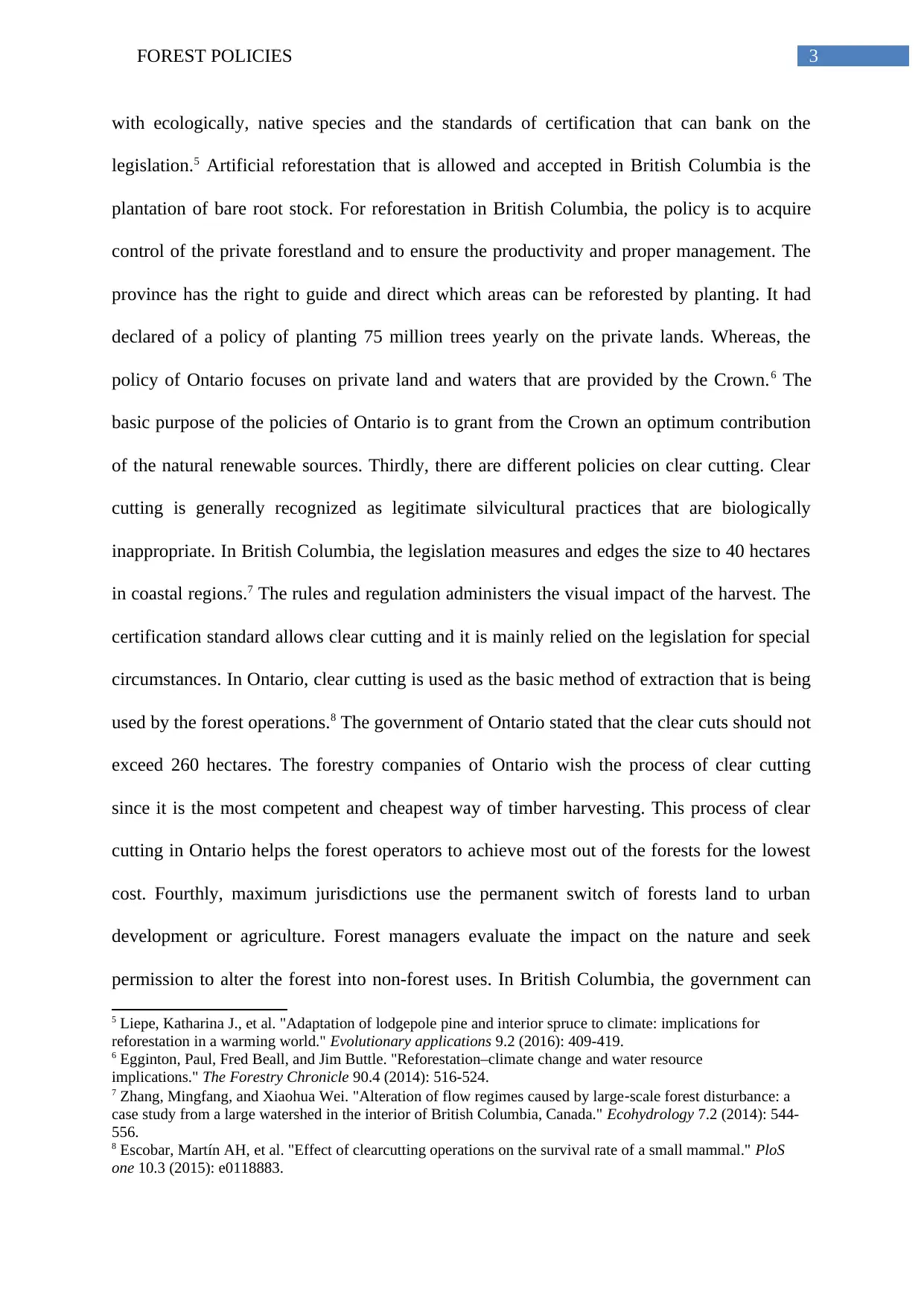
3FOREST POLICIES
with ecologically, native species and the standards of certification that can bank on the
legislation.5 Artificial reforestation that is allowed and accepted in British Columbia is the
plantation of bare root stock. For reforestation in British Columbia, the policy is to acquire
control of the private forestland and to ensure the productivity and proper management. The
province has the right to guide and direct which areas can be reforested by planting. It had
declared of a policy of planting 75 million trees yearly on the private lands. Whereas, the
policy of Ontario focuses on private land and waters that are provided by the Crown.6 The
basic purpose of the policies of Ontario is to grant from the Crown an optimum contribution
of the natural renewable sources. Thirdly, there are different policies on clear cutting. Clear
cutting is generally recognized as legitimate silvicultural practices that are biologically
inappropriate. In British Columbia, the legislation measures and edges the size to 40 hectares
in coastal regions.7 The rules and regulation administers the visual impact of the harvest. The
certification standard allows clear cutting and it is mainly relied on the legislation for special
circumstances. In Ontario, clear cutting is used as the basic method of extraction that is being
used by the forest operations.8 The government of Ontario stated that the clear cuts should not
exceed 260 hectares. The forestry companies of Ontario wish the process of clear cutting
since it is the most competent and cheapest way of timber harvesting. This process of clear
cutting in Ontario helps the forest operators to achieve most out of the forests for the lowest
cost. Fourthly, maximum jurisdictions use the permanent switch of forests land to urban
development or agriculture. Forest managers evaluate the impact on the nature and seek
permission to alter the forest into non-forest uses. In British Columbia, the government can
5 Liepe, Katharina J., et al. "Adaptation of lodgepole pine and interior spruce to climate: implications for
reforestation in a warming world." Evolutionary applications 9.2 (2016): 409-419.
6 Egginton, Paul, Fred Beall, and Jim Buttle. "Reforestation–climate change and water resource
implications." The Forestry Chronicle 90.4 (2014): 516-524.
7 Zhang, Mingfang, and Xiaohua Wei. "Alteration of flow regimes caused by large‐scale forest disturbance: a
case study from a large watershed in the interior of British Columbia, Canada." Ecohydrology 7.2 (2014): 544-
556.
8 Escobar, Martín AH, et al. "Effect of clearcutting operations on the survival rate of a small mammal." PloS
one 10.3 (2015): e0118883.
with ecologically, native species and the standards of certification that can bank on the
legislation.5 Artificial reforestation that is allowed and accepted in British Columbia is the
plantation of bare root stock. For reforestation in British Columbia, the policy is to acquire
control of the private forestland and to ensure the productivity and proper management. The
province has the right to guide and direct which areas can be reforested by planting. It had
declared of a policy of planting 75 million trees yearly on the private lands. Whereas, the
policy of Ontario focuses on private land and waters that are provided by the Crown.6 The
basic purpose of the policies of Ontario is to grant from the Crown an optimum contribution
of the natural renewable sources. Thirdly, there are different policies on clear cutting. Clear
cutting is generally recognized as legitimate silvicultural practices that are biologically
inappropriate. In British Columbia, the legislation measures and edges the size to 40 hectares
in coastal regions.7 The rules and regulation administers the visual impact of the harvest. The
certification standard allows clear cutting and it is mainly relied on the legislation for special
circumstances. In Ontario, clear cutting is used as the basic method of extraction that is being
used by the forest operations.8 The government of Ontario stated that the clear cuts should not
exceed 260 hectares. The forestry companies of Ontario wish the process of clear cutting
since it is the most competent and cheapest way of timber harvesting. This process of clear
cutting in Ontario helps the forest operators to achieve most out of the forests for the lowest
cost. Fourthly, maximum jurisdictions use the permanent switch of forests land to urban
development or agriculture. Forest managers evaluate the impact on the nature and seek
permission to alter the forest into non-forest uses. In British Columbia, the government can
5 Liepe, Katharina J., et al. "Adaptation of lodgepole pine and interior spruce to climate: implications for
reforestation in a warming world." Evolutionary applications 9.2 (2016): 409-419.
6 Egginton, Paul, Fred Beall, and Jim Buttle. "Reforestation–climate change and water resource
implications." The Forestry Chronicle 90.4 (2014): 516-524.
7 Zhang, Mingfang, and Xiaohua Wei. "Alteration of flow regimes caused by large‐scale forest disturbance: a
case study from a large watershed in the interior of British Columbia, Canada." Ecohydrology 7.2 (2014): 544-
556.
8 Escobar, Martín AH, et al. "Effect of clearcutting operations on the survival rate of a small mammal." PloS
one 10.3 (2015): e0118883.
Paraphrase This Document
Need a fresh take? Get an instant paraphrase of this document with our AI Paraphraser
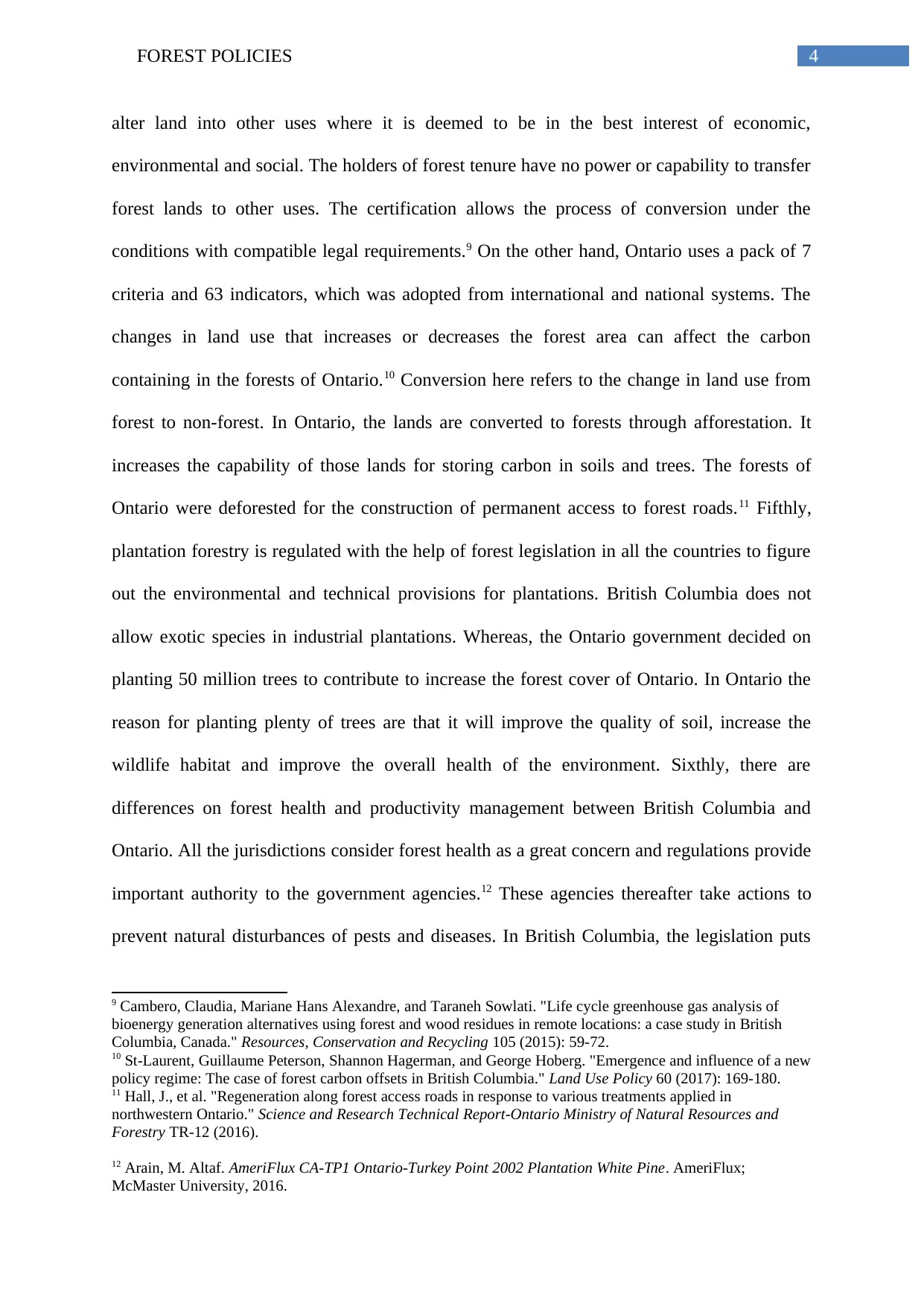
4FOREST POLICIES
alter land into other uses where it is deemed to be in the best interest of economic,
environmental and social. The holders of forest tenure have no power or capability to transfer
forest lands to other uses. The certification allows the process of conversion under the
conditions with compatible legal requirements.9 On the other hand, Ontario uses a pack of 7
criteria and 63 indicators, which was adopted from international and national systems. The
changes in land use that increases or decreases the forest area can affect the carbon
containing in the forests of Ontario.10 Conversion here refers to the change in land use from
forest to non-forest. In Ontario, the lands are converted to forests through afforestation. It
increases the capability of those lands for storing carbon in soils and trees. The forests of
Ontario were deforested for the construction of permanent access to forest roads.11 Fifthly,
plantation forestry is regulated with the help of forest legislation in all the countries to figure
out the environmental and technical provisions for plantations. British Columbia does not
allow exotic species in industrial plantations. Whereas, the Ontario government decided on
planting 50 million trees to contribute to increase the forest cover of Ontario. In Ontario the
reason for planting plenty of trees are that it will improve the quality of soil, increase the
wildlife habitat and improve the overall health of the environment. Sixthly, there are
differences on forest health and productivity management between British Columbia and
Ontario. All the jurisdictions consider forest health as a great concern and regulations provide
important authority to the government agencies.12 These agencies thereafter take actions to
prevent natural disturbances of pests and diseases. In British Columbia, the legislation puts
9 Cambero, Claudia, Mariane Hans Alexandre, and Taraneh Sowlati. "Life cycle greenhouse gas analysis of
bioenergy generation alternatives using forest and wood residues in remote locations: a case study in British
Columbia, Canada." Resources, Conservation and Recycling 105 (2015): 59-72.
10 St-Laurent, Guillaume Peterson, Shannon Hagerman, and George Hoberg. "Emergence and influence of a new
policy regime: The case of forest carbon offsets in British Columbia." Land Use Policy 60 (2017): 169-180.
11 Hall, J., et al. "Regeneration along forest access roads in response to various treatments applied in
northwestern Ontario." Science and Research Technical Report-Ontario Ministry of Natural Resources and
Forestry TR-12 (2016).
12 Arain, M. Altaf. AmeriFlux CA-TP1 Ontario-Turkey Point 2002 Plantation White Pine. AmeriFlux;
McMaster University, 2016.
alter land into other uses where it is deemed to be in the best interest of economic,
environmental and social. The holders of forest tenure have no power or capability to transfer
forest lands to other uses. The certification allows the process of conversion under the
conditions with compatible legal requirements.9 On the other hand, Ontario uses a pack of 7
criteria and 63 indicators, which was adopted from international and national systems. The
changes in land use that increases or decreases the forest area can affect the carbon
containing in the forests of Ontario.10 Conversion here refers to the change in land use from
forest to non-forest. In Ontario, the lands are converted to forests through afforestation. It
increases the capability of those lands for storing carbon in soils and trees. The forests of
Ontario were deforested for the construction of permanent access to forest roads.11 Fifthly,
plantation forestry is regulated with the help of forest legislation in all the countries to figure
out the environmental and technical provisions for plantations. British Columbia does not
allow exotic species in industrial plantations. Whereas, the Ontario government decided on
planting 50 million trees to contribute to increase the forest cover of Ontario. In Ontario the
reason for planting plenty of trees are that it will improve the quality of soil, increase the
wildlife habitat and improve the overall health of the environment. Sixthly, there are
differences on forest health and productivity management between British Columbia and
Ontario. All the jurisdictions consider forest health as a great concern and regulations provide
important authority to the government agencies.12 These agencies thereafter take actions to
prevent natural disturbances of pests and diseases. In British Columbia, the legislation puts
9 Cambero, Claudia, Mariane Hans Alexandre, and Taraneh Sowlati. "Life cycle greenhouse gas analysis of
bioenergy generation alternatives using forest and wood residues in remote locations: a case study in British
Columbia, Canada." Resources, Conservation and Recycling 105 (2015): 59-72.
10 St-Laurent, Guillaume Peterson, Shannon Hagerman, and George Hoberg. "Emergence and influence of a new
policy regime: The case of forest carbon offsets in British Columbia." Land Use Policy 60 (2017): 169-180.
11 Hall, J., et al. "Regeneration along forest access roads in response to various treatments applied in
northwestern Ontario." Science and Research Technical Report-Ontario Ministry of Natural Resources and
Forestry TR-12 (2016).
12 Arain, M. Altaf. AmeriFlux CA-TP1 Ontario-Turkey Point 2002 Plantation White Pine. AmeriFlux;
McMaster University, 2016.
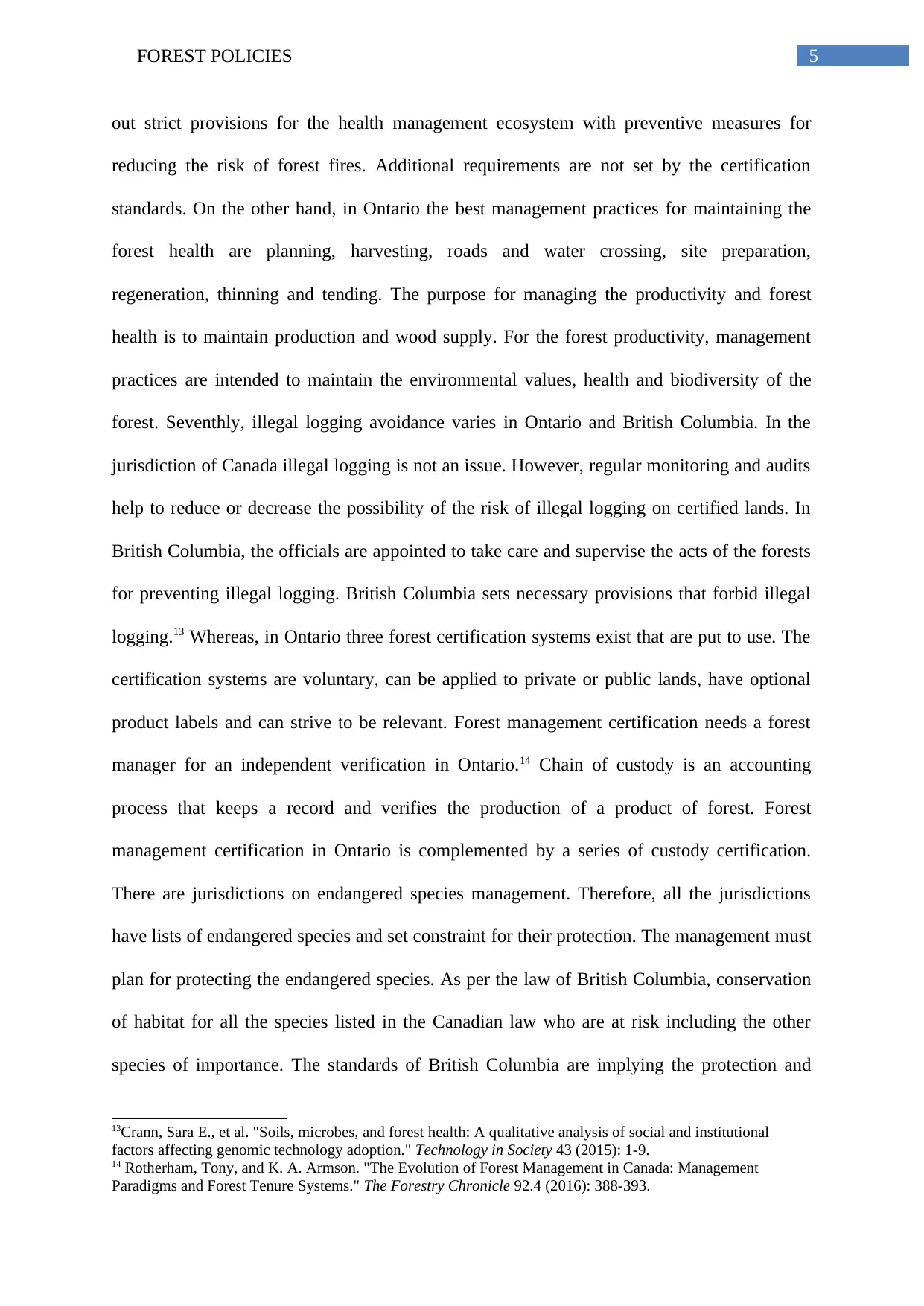
5FOREST POLICIES
out strict provisions for the health management ecosystem with preventive measures for
reducing the risk of forest fires. Additional requirements are not set by the certification
standards. On the other hand, in Ontario the best management practices for maintaining the
forest health are planning, harvesting, roads and water crossing, site preparation,
regeneration, thinning and tending. The purpose for managing the productivity and forest
health is to maintain production and wood supply. For the forest productivity, management
practices are intended to maintain the environmental values, health and biodiversity of the
forest. Seventhly, illegal logging avoidance varies in Ontario and British Columbia. In the
jurisdiction of Canada illegal logging is not an issue. However, regular monitoring and audits
help to reduce or decrease the possibility of the risk of illegal logging on certified lands. In
British Columbia, the officials are appointed to take care and supervise the acts of the forests
for preventing illegal logging. British Columbia sets necessary provisions that forbid illegal
logging.13 Whereas, in Ontario three forest certification systems exist that are put to use. The
certification systems are voluntary, can be applied to private or public lands, have optional
product labels and can strive to be relevant. Forest management certification needs a forest
manager for an independent verification in Ontario.14 Chain of custody is an accounting
process that keeps a record and verifies the production of a product of forest. Forest
management certification in Ontario is complemented by a series of custody certification.
There are jurisdictions on endangered species management. Therefore, all the jurisdictions
have lists of endangered species and set constraint for their protection. The management must
plan for protecting the endangered species. As per the law of British Columbia, conservation
of habitat for all the species listed in the Canadian law who are at risk including the other
species of importance. The standards of British Columbia are implying the protection and
13Crann, Sara E., et al. "Soils, microbes, and forest health: A qualitative analysis of social and institutional
factors affecting genomic technology adoption." Technology in Society 43 (2015): 1-9.
14 Rotherham, Tony, and K. A. Armson. "The Evolution of Forest Management in Canada: Management
Paradigms and Forest Tenure Systems." The Forestry Chronicle 92.4 (2016): 388-393.
out strict provisions for the health management ecosystem with preventive measures for
reducing the risk of forest fires. Additional requirements are not set by the certification
standards. On the other hand, in Ontario the best management practices for maintaining the
forest health are planning, harvesting, roads and water crossing, site preparation,
regeneration, thinning and tending. The purpose for managing the productivity and forest
health is to maintain production and wood supply. For the forest productivity, management
practices are intended to maintain the environmental values, health and biodiversity of the
forest. Seventhly, illegal logging avoidance varies in Ontario and British Columbia. In the
jurisdiction of Canada illegal logging is not an issue. However, regular monitoring and audits
help to reduce or decrease the possibility of the risk of illegal logging on certified lands. In
British Columbia, the officials are appointed to take care and supervise the acts of the forests
for preventing illegal logging. British Columbia sets necessary provisions that forbid illegal
logging.13 Whereas, in Ontario three forest certification systems exist that are put to use. The
certification systems are voluntary, can be applied to private or public lands, have optional
product labels and can strive to be relevant. Forest management certification needs a forest
manager for an independent verification in Ontario.14 Chain of custody is an accounting
process that keeps a record and verifies the production of a product of forest. Forest
management certification in Ontario is complemented by a series of custody certification.
There are jurisdictions on endangered species management. Therefore, all the jurisdictions
have lists of endangered species and set constraint for their protection. The management must
plan for protecting the endangered species. As per the law of British Columbia, conservation
of habitat for all the species listed in the Canadian law who are at risk including the other
species of importance. The standards of British Columbia are implying the protection and
13Crann, Sara E., et al. "Soils, microbes, and forest health: A qualitative analysis of social and institutional
factors affecting genomic technology adoption." Technology in Society 43 (2015): 1-9.
14 Rotherham, Tony, and K. A. Armson. "The Evolution of Forest Management in Canada: Management
Paradigms and Forest Tenure Systems." The Forestry Chronicle 92.4 (2016): 388-393.
⊘ This is a preview!⊘
Do you want full access?
Subscribe today to unlock all pages.

Trusted by 1+ million students worldwide
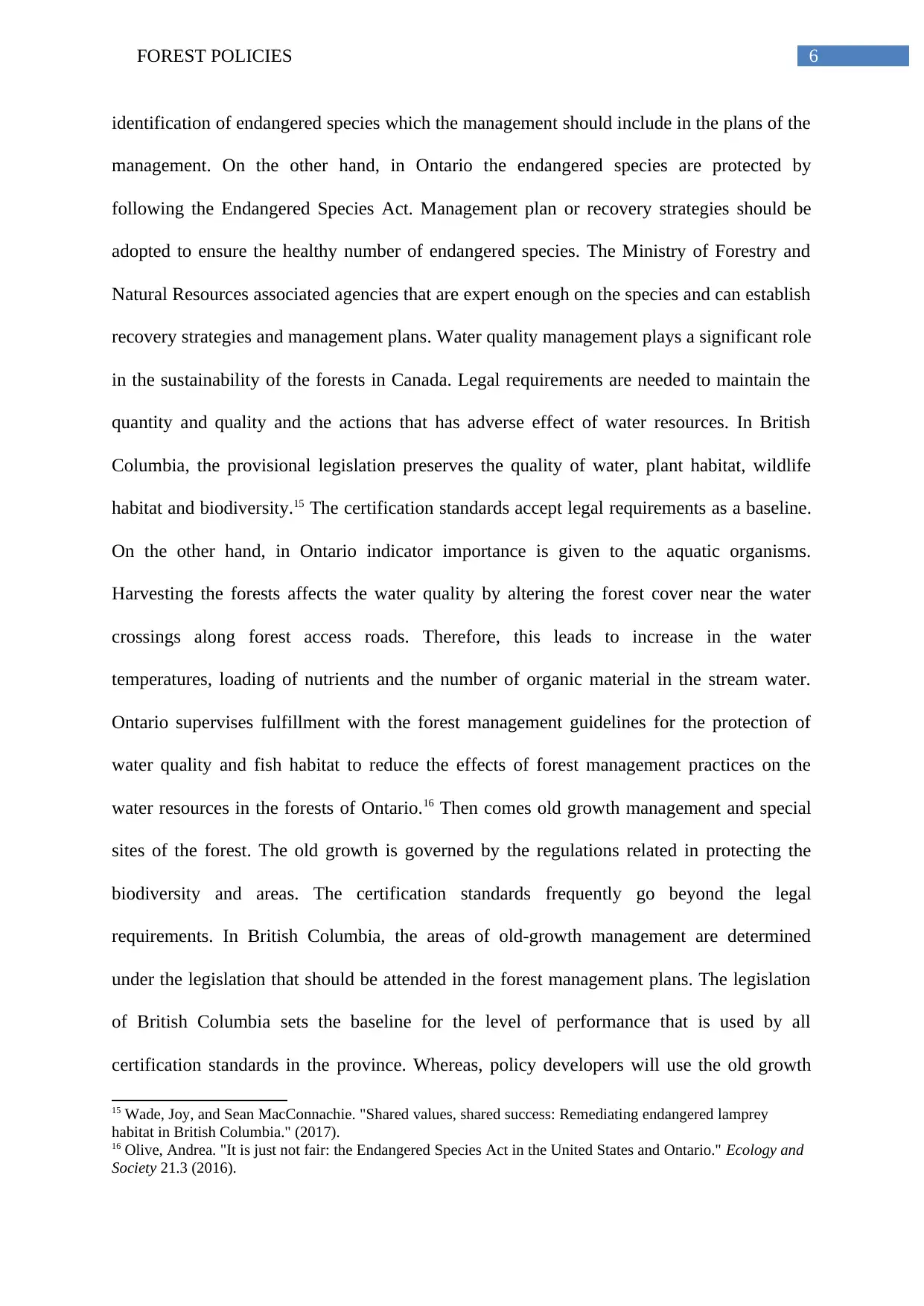
6FOREST POLICIES
identification of endangered species which the management should include in the plans of the
management. On the other hand, in Ontario the endangered species are protected by
following the Endangered Species Act. Management plan or recovery strategies should be
adopted to ensure the healthy number of endangered species. The Ministry of Forestry and
Natural Resources associated agencies that are expert enough on the species and can establish
recovery strategies and management plans. Water quality management plays a significant role
in the sustainability of the forests in Canada. Legal requirements are needed to maintain the
quantity and quality and the actions that has adverse effect of water resources. In British
Columbia, the provisional legislation preserves the quality of water, plant habitat, wildlife
habitat and biodiversity.15 The certification standards accept legal requirements as a baseline.
On the other hand, in Ontario indicator importance is given to the aquatic organisms.
Harvesting the forests affects the water quality by altering the forest cover near the water
crossings along forest access roads. Therefore, this leads to increase in the water
temperatures, loading of nutrients and the number of organic material in the stream water.
Ontario supervises fulfillment with the forest management guidelines for the protection of
water quality and fish habitat to reduce the effects of forest management practices on the
water resources in the forests of Ontario.16 Then comes old growth management and special
sites of the forest. The old growth is governed by the regulations related in protecting the
biodiversity and areas. The certification standards frequently go beyond the legal
requirements. In British Columbia, the areas of old-growth management are determined
under the legislation that should be attended in the forest management plans. The legislation
of British Columbia sets the baseline for the level of performance that is used by all
certification standards in the province. Whereas, policy developers will use the old growth
15 Wade, Joy, and Sean MacConnachie. "Shared values, shared success: Remediating endangered lamprey
habitat in British Columbia." (2017).
16 Olive, Andrea. "It is just not fair: the Endangered Species Act in the United States and Ontario." Ecology and
Society 21.3 (2016).
identification of endangered species which the management should include in the plans of the
management. On the other hand, in Ontario the endangered species are protected by
following the Endangered Species Act. Management plan or recovery strategies should be
adopted to ensure the healthy number of endangered species. The Ministry of Forestry and
Natural Resources associated agencies that are expert enough on the species and can establish
recovery strategies and management plans. Water quality management plays a significant role
in the sustainability of the forests in Canada. Legal requirements are needed to maintain the
quantity and quality and the actions that has adverse effect of water resources. In British
Columbia, the provisional legislation preserves the quality of water, plant habitat, wildlife
habitat and biodiversity.15 The certification standards accept legal requirements as a baseline.
On the other hand, in Ontario indicator importance is given to the aquatic organisms.
Harvesting the forests affects the water quality by altering the forest cover near the water
crossings along forest access roads. Therefore, this leads to increase in the water
temperatures, loading of nutrients and the number of organic material in the stream water.
Ontario supervises fulfillment with the forest management guidelines for the protection of
water quality and fish habitat to reduce the effects of forest management practices on the
water resources in the forests of Ontario.16 Then comes old growth management and special
sites of the forest. The old growth is governed by the regulations related in protecting the
biodiversity and areas. The certification standards frequently go beyond the legal
requirements. In British Columbia, the areas of old-growth management are determined
under the legislation that should be attended in the forest management plans. The legislation
of British Columbia sets the baseline for the level of performance that is used by all
certification standards in the province. Whereas, policy developers will use the old growth
15 Wade, Joy, and Sean MacConnachie. "Shared values, shared success: Remediating endangered lamprey
habitat in British Columbia." (2017).
16 Olive, Andrea. "It is just not fair: the Endangered Species Act in the United States and Ontario." Ecology and
Society 21.3 (2016).
Paraphrase This Document
Need a fresh take? Get an instant paraphrase of this document with our AI Paraphraser
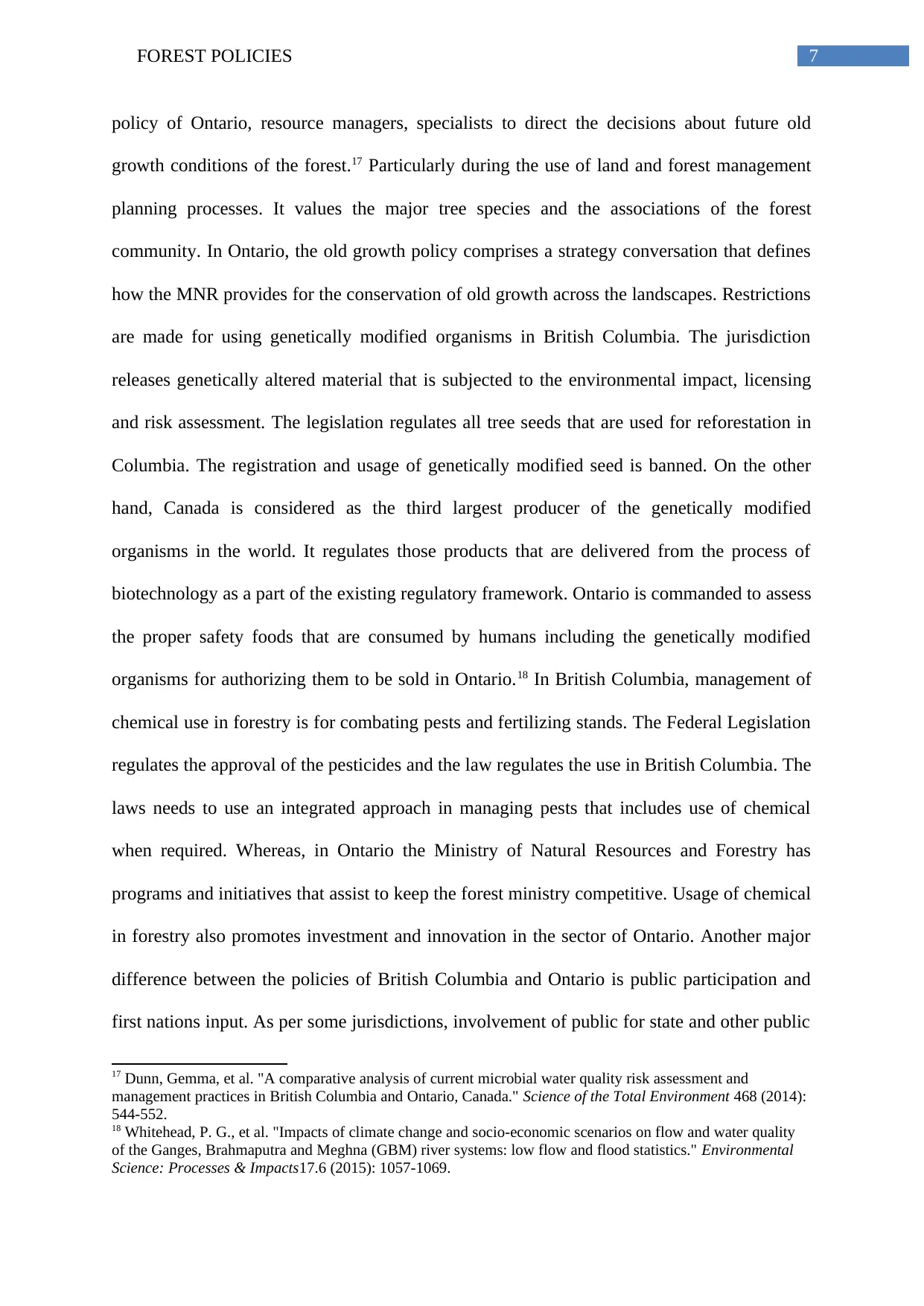
7FOREST POLICIES
policy of Ontario, resource managers, specialists to direct the decisions about future old
growth conditions of the forest.17 Particularly during the use of land and forest management
planning processes. It values the major tree species and the associations of the forest
community. In Ontario, the old growth policy comprises a strategy conversation that defines
how the MNR provides for the conservation of old growth across the landscapes. Restrictions
are made for using genetically modified organisms in British Columbia. The jurisdiction
releases genetically altered material that is subjected to the environmental impact, licensing
and risk assessment. The legislation regulates all tree seeds that are used for reforestation in
Columbia. The registration and usage of genetically modified seed is banned. On the other
hand, Canada is considered as the third largest producer of the genetically modified
organisms in the world. It regulates those products that are delivered from the process of
biotechnology as a part of the existing regulatory framework. Ontario is commanded to assess
the proper safety foods that are consumed by humans including the genetically modified
organisms for authorizing them to be sold in Ontario.18 In British Columbia, management of
chemical use in forestry is for combating pests and fertilizing stands. The Federal Legislation
regulates the approval of the pesticides and the law regulates the use in British Columbia. The
laws needs to use an integrated approach in managing pests that includes use of chemical
when required. Whereas, in Ontario the Ministry of Natural Resources and Forestry has
programs and initiatives that assist to keep the forest ministry competitive. Usage of chemical
in forestry also promotes investment and innovation in the sector of Ontario. Another major
difference between the policies of British Columbia and Ontario is public participation and
first nations input. As per some jurisdictions, involvement of public for state and other public
17 Dunn, Gemma, et al. "A comparative analysis of current microbial water quality risk assessment and
management practices in British Columbia and Ontario, Canada." Science of the Total Environment 468 (2014):
544-552.
18 Whitehead, P. G., et al. "Impacts of climate change and socio-economic scenarios on flow and water quality
of the Ganges, Brahmaputra and Meghna (GBM) river systems: low flow and flood statistics." Environmental
Science: Processes & Impacts17.6 (2015): 1057-1069.
policy of Ontario, resource managers, specialists to direct the decisions about future old
growth conditions of the forest.17 Particularly during the use of land and forest management
planning processes. It values the major tree species and the associations of the forest
community. In Ontario, the old growth policy comprises a strategy conversation that defines
how the MNR provides for the conservation of old growth across the landscapes. Restrictions
are made for using genetically modified organisms in British Columbia. The jurisdiction
releases genetically altered material that is subjected to the environmental impact, licensing
and risk assessment. The legislation regulates all tree seeds that are used for reforestation in
Columbia. The registration and usage of genetically modified seed is banned. On the other
hand, Canada is considered as the third largest producer of the genetically modified
organisms in the world. It regulates those products that are delivered from the process of
biotechnology as a part of the existing regulatory framework. Ontario is commanded to assess
the proper safety foods that are consumed by humans including the genetically modified
organisms for authorizing them to be sold in Ontario.18 In British Columbia, management of
chemical use in forestry is for combating pests and fertilizing stands. The Federal Legislation
regulates the approval of the pesticides and the law regulates the use in British Columbia. The
laws needs to use an integrated approach in managing pests that includes use of chemical
when required. Whereas, in Ontario the Ministry of Natural Resources and Forestry has
programs and initiatives that assist to keep the forest ministry competitive. Usage of chemical
in forestry also promotes investment and innovation in the sector of Ontario. Another major
difference between the policies of British Columbia and Ontario is public participation and
first nations input. As per some jurisdictions, involvement of public for state and other public
17 Dunn, Gemma, et al. "A comparative analysis of current microbial water quality risk assessment and
management practices in British Columbia and Ontario, Canada." Science of the Total Environment 468 (2014):
544-552.
18 Whitehead, P. G., et al. "Impacts of climate change and socio-economic scenarios on flow and water quality
of the Ganges, Brahmaputra and Meghna (GBM) river systems: low flow and flood statistics." Environmental
Science: Processes & Impacts17.6 (2015): 1057-1069.
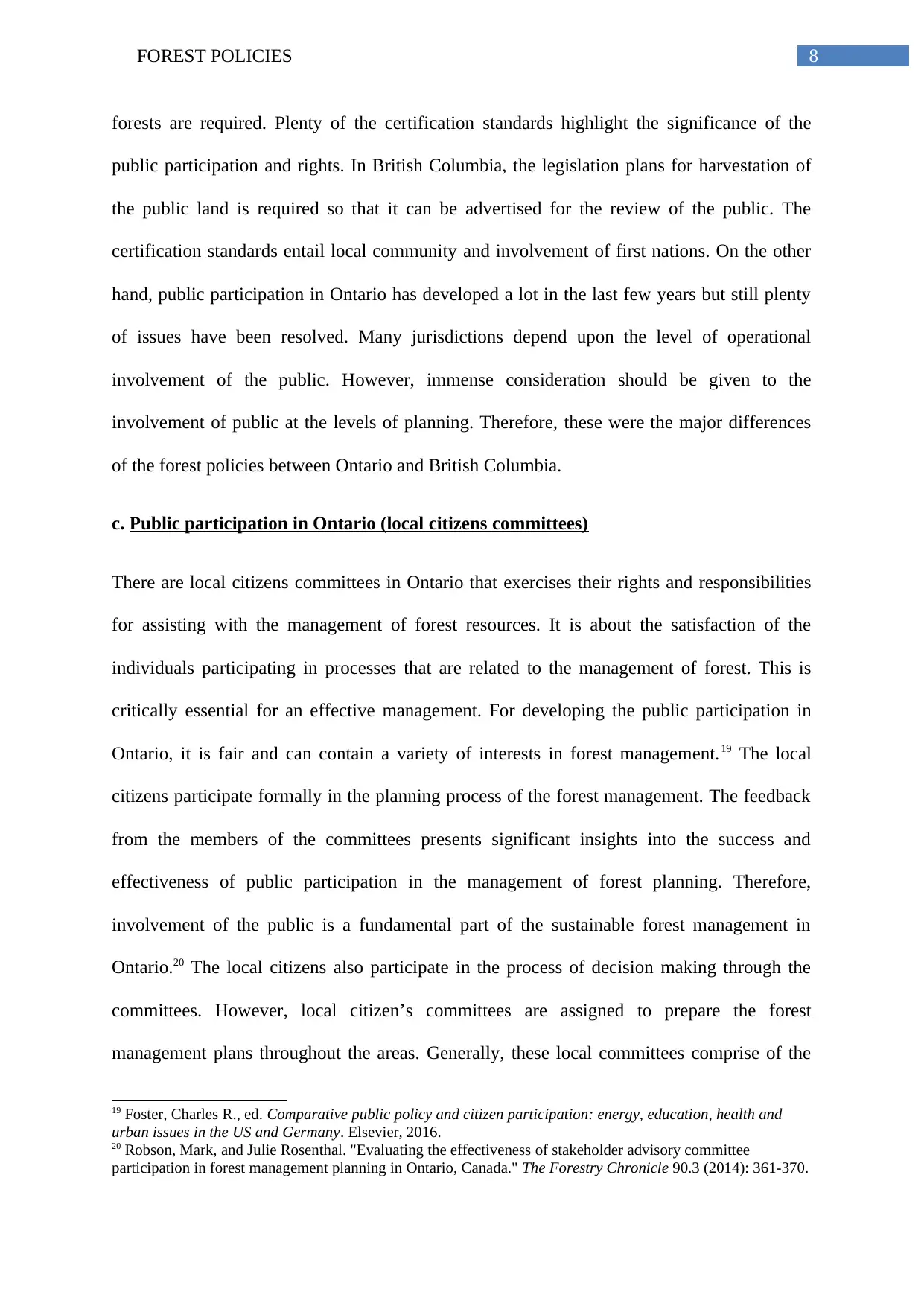
8FOREST POLICIES
forests are required. Plenty of the certification standards highlight the significance of the
public participation and rights. In British Columbia, the legislation plans for harvestation of
the public land is required so that it can be advertised for the review of the public. The
certification standards entail local community and involvement of first nations. On the other
hand, public participation in Ontario has developed a lot in the last few years but still plenty
of issues have been resolved. Many jurisdictions depend upon the level of operational
involvement of the public. However, immense consideration should be given to the
involvement of public at the levels of planning. Therefore, these were the major differences
of the forest policies between Ontario and British Columbia.
c. Public participation in Ontario (local citizens committees)
There are local citizens committees in Ontario that exercises their rights and responsibilities
for assisting with the management of forest resources. It is about the satisfaction of the
individuals participating in processes that are related to the management of forest. This is
critically essential for an effective management. For developing the public participation in
Ontario, it is fair and can contain a variety of interests in forest management.19 The local
citizens participate formally in the planning process of the forest management. The feedback
from the members of the committees presents significant insights into the success and
effectiveness of public participation in the management of forest planning. Therefore,
involvement of the public is a fundamental part of the sustainable forest management in
Ontario.20 The local citizens also participate in the process of decision making through the
committees. However, local citizen’s committees are assigned to prepare the forest
management plans throughout the areas. Generally, these local committees comprise of the
19 Foster, Charles R., ed. Comparative public policy and citizen participation: energy, education, health and
urban issues in the US and Germany. Elsevier, 2016.
20 Robson, Mark, and Julie Rosenthal. "Evaluating the effectiveness of stakeholder advisory committee
participation in forest management planning in Ontario, Canada." The Forestry Chronicle 90.3 (2014): 361-370.
forests are required. Plenty of the certification standards highlight the significance of the
public participation and rights. In British Columbia, the legislation plans for harvestation of
the public land is required so that it can be advertised for the review of the public. The
certification standards entail local community and involvement of first nations. On the other
hand, public participation in Ontario has developed a lot in the last few years but still plenty
of issues have been resolved. Many jurisdictions depend upon the level of operational
involvement of the public. However, immense consideration should be given to the
involvement of public at the levels of planning. Therefore, these were the major differences
of the forest policies between Ontario and British Columbia.
c. Public participation in Ontario (local citizens committees)
There are local citizens committees in Ontario that exercises their rights and responsibilities
for assisting with the management of forest resources. It is about the satisfaction of the
individuals participating in processes that are related to the management of forest. This is
critically essential for an effective management. For developing the public participation in
Ontario, it is fair and can contain a variety of interests in forest management.19 The local
citizens participate formally in the planning process of the forest management. The feedback
from the members of the committees presents significant insights into the success and
effectiveness of public participation in the management of forest planning. Therefore,
involvement of the public is a fundamental part of the sustainable forest management in
Ontario.20 The local citizens also participate in the process of decision making through the
committees. However, local citizen’s committees are assigned to prepare the forest
management plans throughout the areas. Generally, these local committees comprise of the
19 Foster, Charles R., ed. Comparative public policy and citizen participation: energy, education, health and
urban issues in the US and Germany. Elsevier, 2016.
20 Robson, Mark, and Julie Rosenthal. "Evaluating the effectiveness of stakeholder advisory committee
participation in forest management planning in Ontario, Canada." The Forestry Chronicle 90.3 (2014): 361-370.
⊘ This is a preview!⊘
Do you want full access?
Subscribe today to unlock all pages.

Trusted by 1+ million students worldwide
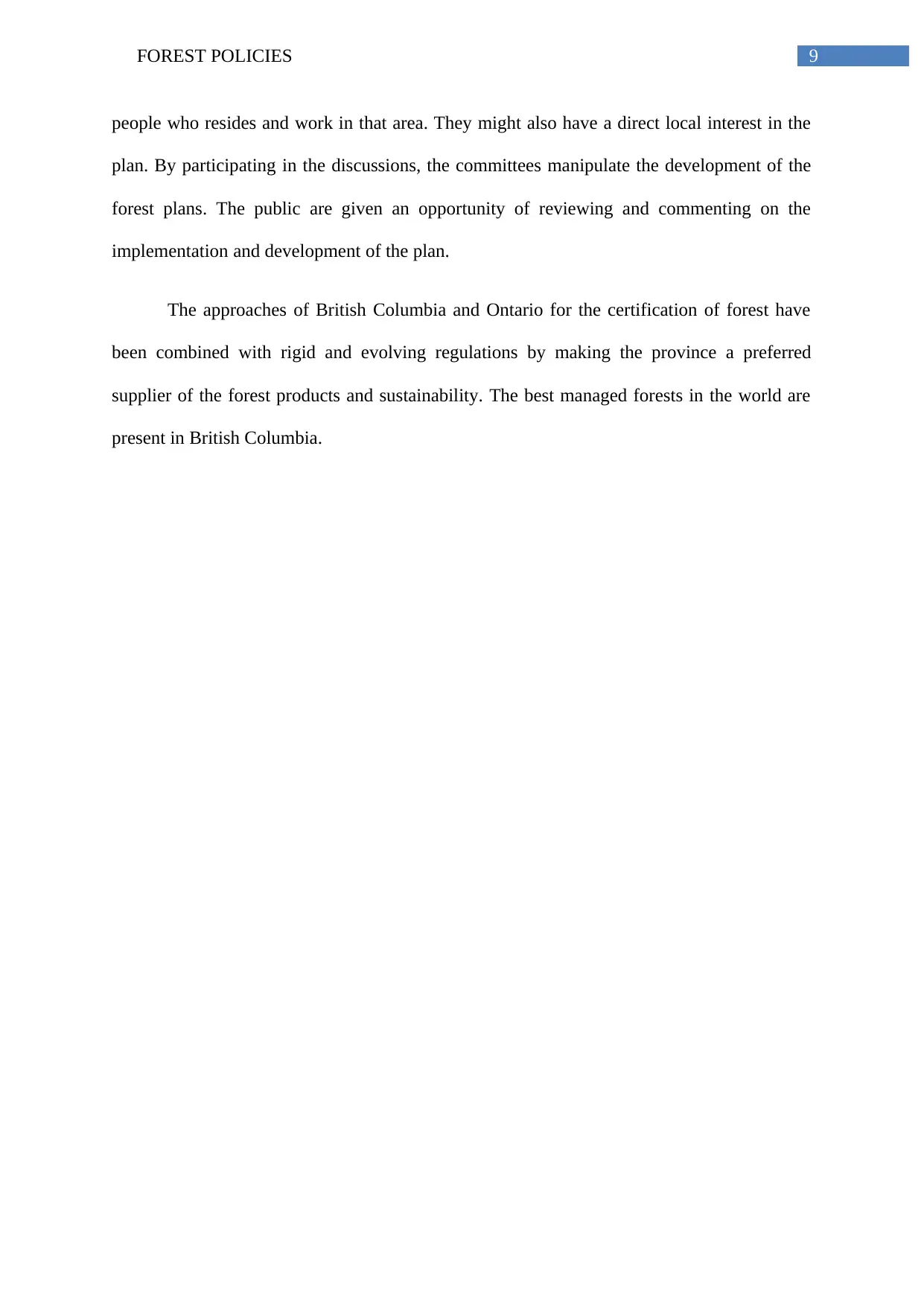
9FOREST POLICIES
people who resides and work in that area. They might also have a direct local interest in the
plan. By participating in the discussions, the committees manipulate the development of the
forest plans. The public are given an opportunity of reviewing and commenting on the
implementation and development of the plan.
The approaches of British Columbia and Ontario for the certification of forest have
been combined with rigid and evolving regulations by making the province a preferred
supplier of the forest products and sustainability. The best managed forests in the world are
present in British Columbia.
people who resides and work in that area. They might also have a direct local interest in the
plan. By participating in the discussions, the committees manipulate the development of the
forest plans. The public are given an opportunity of reviewing and commenting on the
implementation and development of the plan.
The approaches of British Columbia and Ontario for the certification of forest have
been combined with rigid and evolving regulations by making the province a preferred
supplier of the forest products and sustainability. The best managed forests in the world are
present in British Columbia.
Paraphrase This Document
Need a fresh take? Get an instant paraphrase of this document with our AI Paraphraser
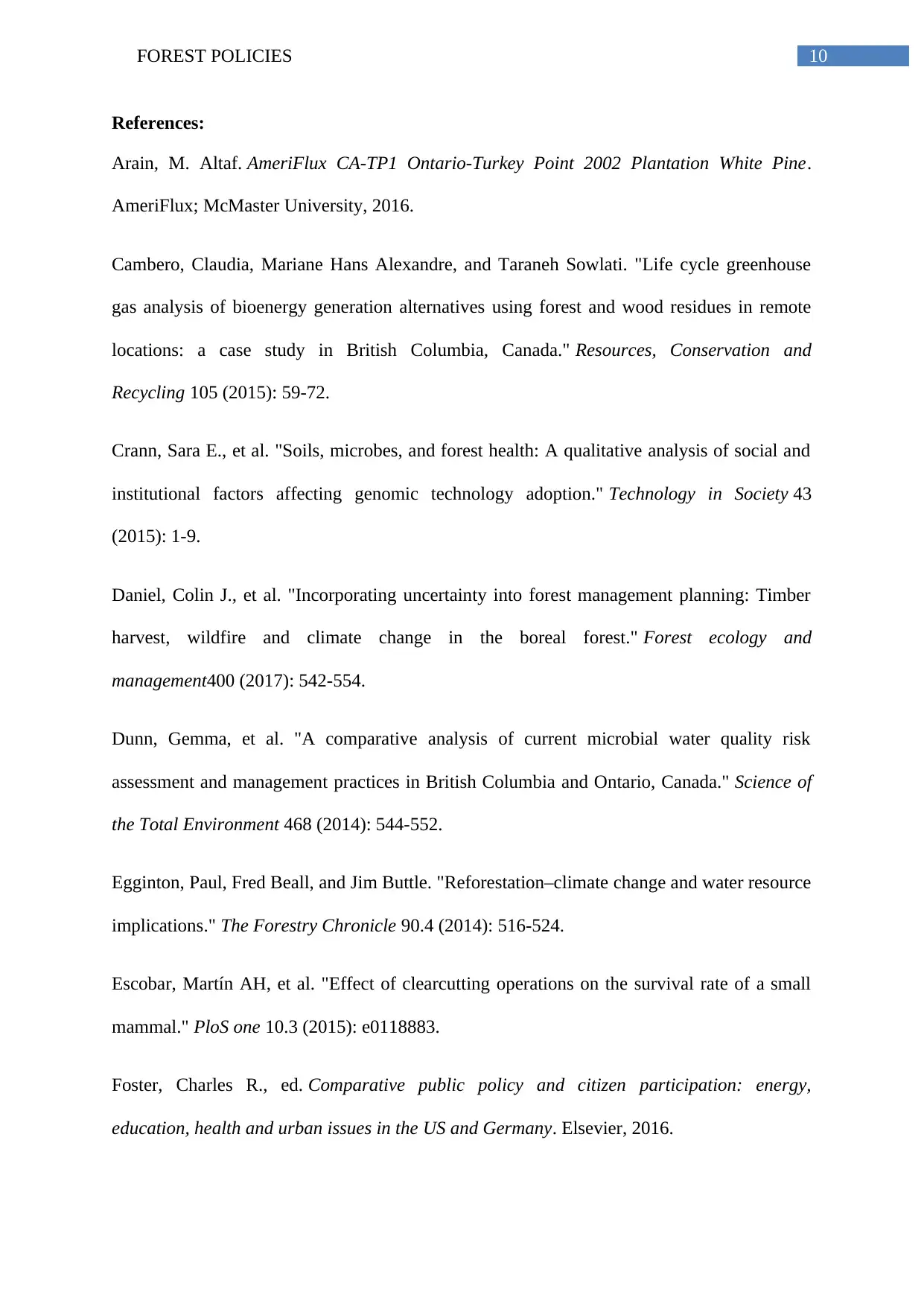
10FOREST POLICIES
References:
Arain, M. Altaf. AmeriFlux CA-TP1 Ontario-Turkey Point 2002 Plantation White Pine.
AmeriFlux; McMaster University, 2016.
Cambero, Claudia, Mariane Hans Alexandre, and Taraneh Sowlati. "Life cycle greenhouse
gas analysis of bioenergy generation alternatives using forest and wood residues in remote
locations: a case study in British Columbia, Canada." Resources, Conservation and
Recycling 105 (2015): 59-72.
Crann, Sara E., et al. "Soils, microbes, and forest health: A qualitative analysis of social and
institutional factors affecting genomic technology adoption." Technology in Society 43
(2015): 1-9.
Daniel, Colin J., et al. "Incorporating uncertainty into forest management planning: Timber
harvest, wildfire and climate change in the boreal forest." Forest ecology and
management400 (2017): 542-554.
Dunn, Gemma, et al. "A comparative analysis of current microbial water quality risk
assessment and management practices in British Columbia and Ontario, Canada." Science of
the Total Environment 468 (2014): 544-552.
Egginton, Paul, Fred Beall, and Jim Buttle. "Reforestation–climate change and water resource
implications." The Forestry Chronicle 90.4 (2014): 516-524.
Escobar, Martín AH, et al. "Effect of clearcutting operations on the survival rate of a small
mammal." PloS one 10.3 (2015): e0118883.
Foster, Charles R., ed. Comparative public policy and citizen participation: energy,
education, health and urban issues in the US and Germany. Elsevier, 2016.
References:
Arain, M. Altaf. AmeriFlux CA-TP1 Ontario-Turkey Point 2002 Plantation White Pine.
AmeriFlux; McMaster University, 2016.
Cambero, Claudia, Mariane Hans Alexandre, and Taraneh Sowlati. "Life cycle greenhouse
gas analysis of bioenergy generation alternatives using forest and wood residues in remote
locations: a case study in British Columbia, Canada." Resources, Conservation and
Recycling 105 (2015): 59-72.
Crann, Sara E., et al. "Soils, microbes, and forest health: A qualitative analysis of social and
institutional factors affecting genomic technology adoption." Technology in Society 43
(2015): 1-9.
Daniel, Colin J., et al. "Incorporating uncertainty into forest management planning: Timber
harvest, wildfire and climate change in the boreal forest." Forest ecology and
management400 (2017): 542-554.
Dunn, Gemma, et al. "A comparative analysis of current microbial water quality risk
assessment and management practices in British Columbia and Ontario, Canada." Science of
the Total Environment 468 (2014): 544-552.
Egginton, Paul, Fred Beall, and Jim Buttle. "Reforestation–climate change and water resource
implications." The Forestry Chronicle 90.4 (2014): 516-524.
Escobar, Martín AH, et al. "Effect of clearcutting operations on the survival rate of a small
mammal." PloS one 10.3 (2015): e0118883.
Foster, Charles R., ed. Comparative public policy and citizen participation: energy,
education, health and urban issues in the US and Germany. Elsevier, 2016.
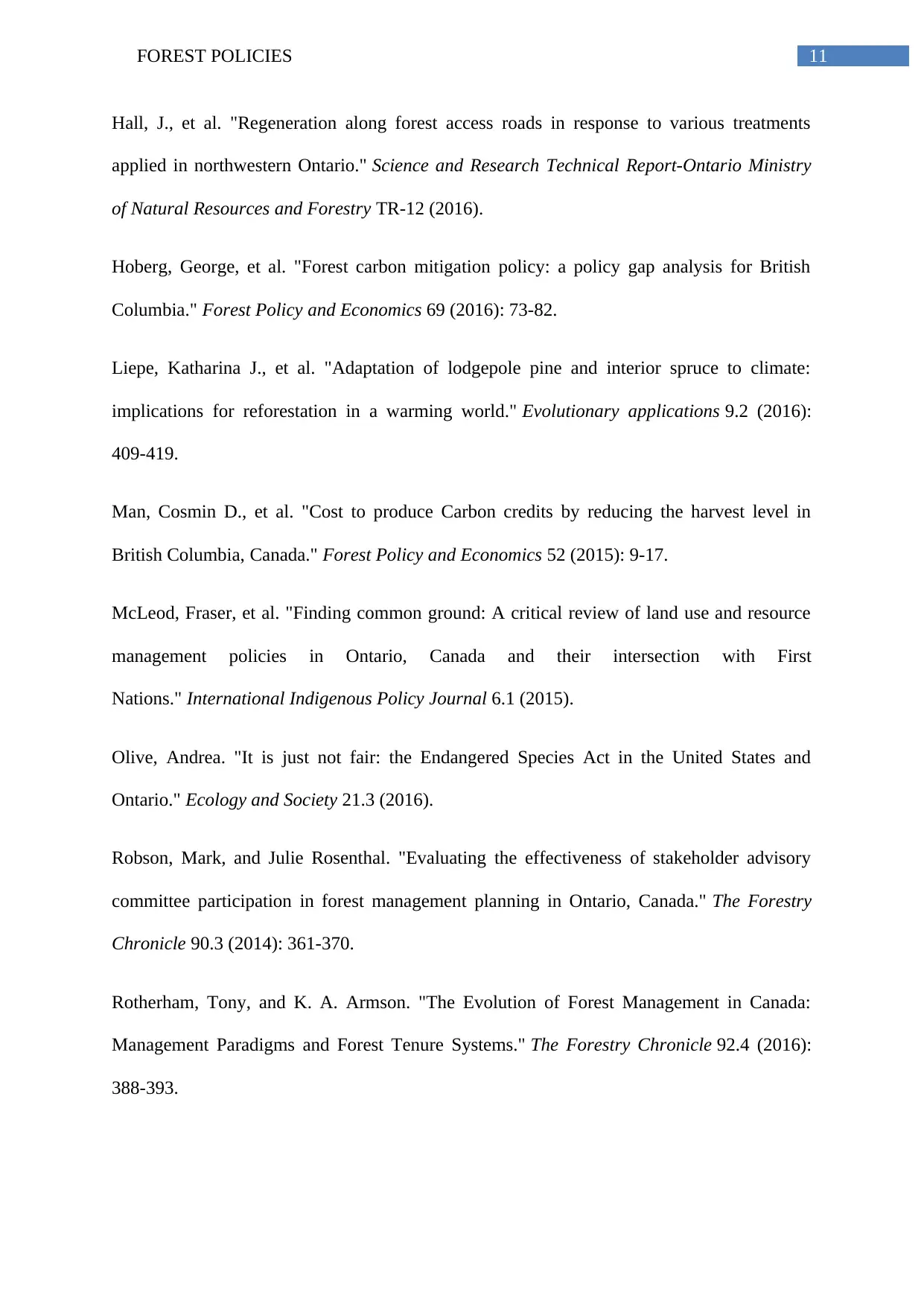
11FOREST POLICIES
Hall, J., et al. "Regeneration along forest access roads in response to various treatments
applied in northwestern Ontario." Science and Research Technical Report-Ontario Ministry
of Natural Resources and Forestry TR-12 (2016).
Hoberg, George, et al. "Forest carbon mitigation policy: a policy gap analysis for British
Columbia." Forest Policy and Economics 69 (2016): 73-82.
Liepe, Katharina J., et al. "Adaptation of lodgepole pine and interior spruce to climate:
implications for reforestation in a warming world." Evolutionary applications 9.2 (2016):
409-419.
Man, Cosmin D., et al. "Cost to produce Carbon credits by reducing the harvest level in
British Columbia, Canada." Forest Policy and Economics 52 (2015): 9-17.
McLeod, Fraser, et al. "Finding common ground: A critical review of land use and resource
management policies in Ontario, Canada and their intersection with First
Nations." International Indigenous Policy Journal 6.1 (2015).
Olive, Andrea. "It is just not fair: the Endangered Species Act in the United States and
Ontario." Ecology and Society 21.3 (2016).
Robson, Mark, and Julie Rosenthal. "Evaluating the effectiveness of stakeholder advisory
committee participation in forest management planning in Ontario, Canada." The Forestry
Chronicle 90.3 (2014): 361-370.
Rotherham, Tony, and K. A. Armson. "The Evolution of Forest Management in Canada:
Management Paradigms and Forest Tenure Systems." The Forestry Chronicle 92.4 (2016):
388-393.
Hall, J., et al. "Regeneration along forest access roads in response to various treatments
applied in northwestern Ontario." Science and Research Technical Report-Ontario Ministry
of Natural Resources and Forestry TR-12 (2016).
Hoberg, George, et al. "Forest carbon mitigation policy: a policy gap analysis for British
Columbia." Forest Policy and Economics 69 (2016): 73-82.
Liepe, Katharina J., et al. "Adaptation of lodgepole pine and interior spruce to climate:
implications for reforestation in a warming world." Evolutionary applications 9.2 (2016):
409-419.
Man, Cosmin D., et al. "Cost to produce Carbon credits by reducing the harvest level in
British Columbia, Canada." Forest Policy and Economics 52 (2015): 9-17.
McLeod, Fraser, et al. "Finding common ground: A critical review of land use and resource
management policies in Ontario, Canada and their intersection with First
Nations." International Indigenous Policy Journal 6.1 (2015).
Olive, Andrea. "It is just not fair: the Endangered Species Act in the United States and
Ontario." Ecology and Society 21.3 (2016).
Robson, Mark, and Julie Rosenthal. "Evaluating the effectiveness of stakeholder advisory
committee participation in forest management planning in Ontario, Canada." The Forestry
Chronicle 90.3 (2014): 361-370.
Rotherham, Tony, and K. A. Armson. "The Evolution of Forest Management in Canada:
Management Paradigms and Forest Tenure Systems." The Forestry Chronicle 92.4 (2016):
388-393.
⊘ This is a preview!⊘
Do you want full access?
Subscribe today to unlock all pages.

Trusted by 1+ million students worldwide
1 out of 13
Related Documents
Your All-in-One AI-Powered Toolkit for Academic Success.
+13062052269
info@desklib.com
Available 24*7 on WhatsApp / Email
![[object Object]](/_next/static/media/star-bottom.7253800d.svg)
Unlock your academic potential
Copyright © 2020–2025 A2Z Services. All Rights Reserved. Developed and managed by ZUCOL.





